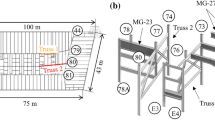Abstract
The subject of the paper is the collapse of towers and highscrapers, particularly, the collapse of the World Trade Center towers in New York on September 11, 2001. The deduced equations of progressive collapse are used to refute the generally accepted opinion of experts about progressive collapse of the WTC towers in the free-fall regime, which is the official version of the US government. It is proved that progressive collapse is much slower than free fall. The critical floors where collapses started from are estimated using the well-established fact of the free-fall time of all WTC collapses. To this end, the most comprehensive “hybrid” analysis is advanced taking into account that collapses could start on several floors simultaneously, not on one floor as suggested before. According to this “hybrid” model, at the first stage, several floors collapsed simultaneously as a result of fracture waves causing a dust cloud and, at the second stage, the lower part of tower being intact in the first stage collapsed in the regime of progressive failure. Five different collapse types are studied, including the fastest and slowest collapses, and then the hybrid mode is examined with initial collapse of several floors followed by the “domino-effect” of the remaining floors. It is established that the floors where the WTC collapses started from were located significantly lower than the floors hit by the terrorists and subjected to fire. This conclusion confirms the same former result obtained by using the simple official theory of pure progressive collapse.
Similar content being viewed by others
References
Z. P. Bazant and M. Verdure, “Mechanics of progressive collapse, Report No. 06-06/c605T,” in: Dept. of Civil and Environmental Engineering, Northwestern University, Evanston, Illinois 60208, USA (2006), pp. 1–14.
Z. P. Bazant and Y. Zhou, “Why did World Trade Center collapse?,” J. Eng. Mech., 128(1), 1–6 (2002).
G. P. Cherepanov, “September 11 and facture mechanics,” Int. J. Fracture, 132, No. 2, L25–L26 (2005).
G. P. Cherepanov, “Mechanics of the WTC collapse,” Int. J. Fracture, 141, 287–289 (2006).
G. P. Cherepanov, “On the collapse of World Trade Center in New York on September 11, 2001,” Int. J. En. Automat. Probl., No. 1, 10–20 (2006).
G. P. Cherepanov and I. E. Esparragoza, “Progressive collapse of towers: the resistance effect,” Int. J. Fracture, 143, 203–206 (2007).
G. P. Cherepanov, A Critical Analysis of the Government's Theory: The Collapse of the New York Towers on Sept. 11, 2001 (to be published).
Author information
Authors and Affiliations
Additional information
Published in Fizyko-Khimichna Mekhanika Materialiv, Vol. 44, No. 4, pp. 26–34, July–August, 2008.
Rights and permissions
About this article
Cite this article
Cherepanov, G.P. Collapse of towers as applied to September 11 events. Mater Sci 44, 489–499 (2008). https://doi.org/10.1007/s11003-009-9119-1
Received:
Published:
Issue Date:
DOI: https://doi.org/10.1007/s11003-009-9119-1



